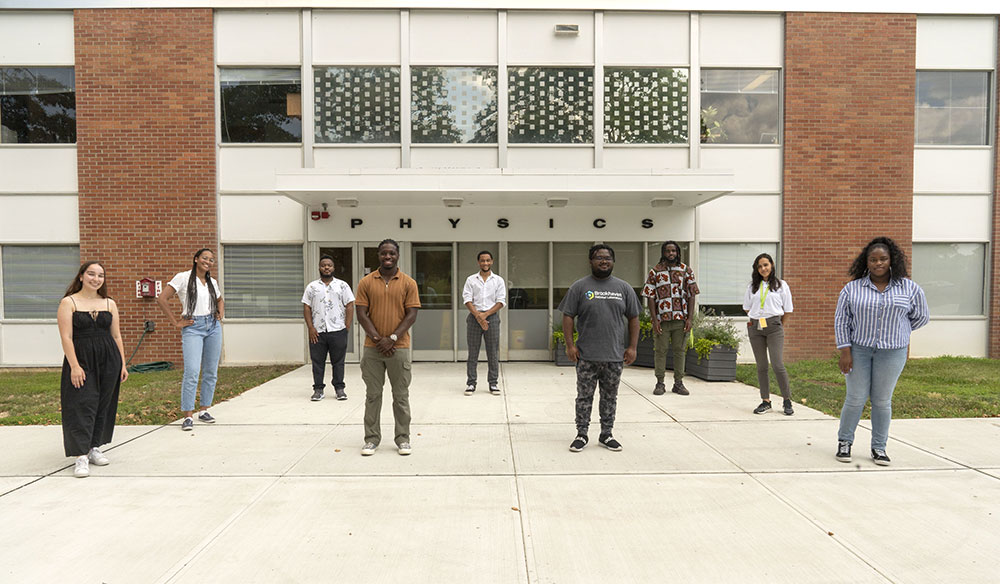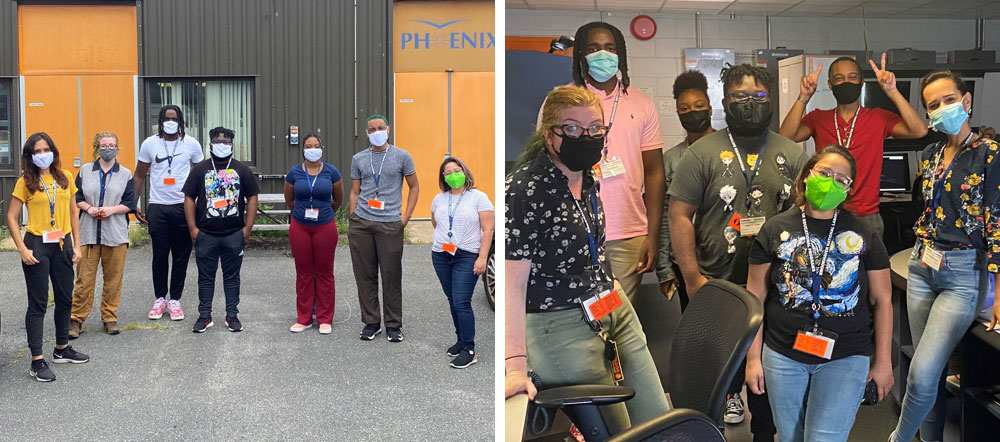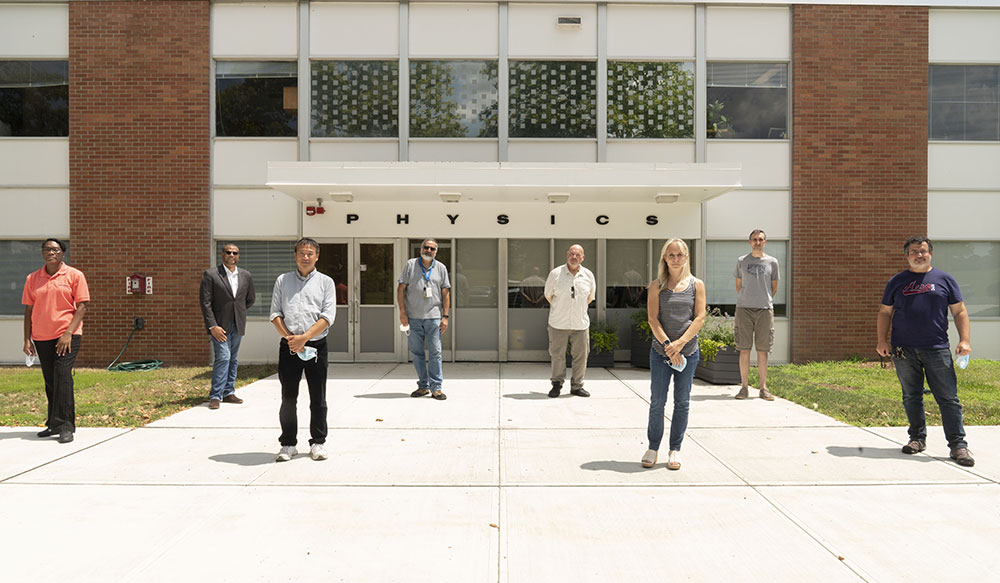Traineeships Aim to Boost Inclusion, Support Minorities in Nuclear Physics
Successful DOE pilot traineeship program aimed at bolstering representation of Black, Hispanic, and other minorities in the field will continue, expand opportunities
September 11, 2023
 enlarge
enlarge
Trainees Caroline Esposito, Jordan Dias-Gaylor, Allen Pierre-Louis, Kolby Davis, Kurt Kennedy, Marcus McLaurin, Khadim Mbacke, Ambar Rodriguez, and Laurynette Griffin conducted research at Brookhaven Lab last summer.
Ambar Rodriguez-Alicea wants to explore the very basics of matter and the universe as we know it. As the aspiring physicist from Puerto Rico puts it, “I want a job that forces me to keep learning until the end.”
Still, with that clear goal in mind, Rodriguez-Alicea entered her last year at the University of Puerto Rico-Mayagüez unsure if she should move on to a graduate program in physics. She wasn’t sure if she had gained enough hands-on research experience to continue in the field.
Her outlook about her readiness for graduate school changed after she joined a traineeship at the U.S. Department of Energy’s (DOE) Brookhaven National Laboratory for an up-close physics opportunity.
Brookhaven Lab is among 11 institutions that in 2021 shared a $2.85 million DOE award to broaden and diversify the nuclear and particle physics research communities through a pilot program for research traineeships for undergraduates from Historically Black Colleges and Universities (HBCUs) and other Minority Serving Institutions (MSIs). The traineeship program at Brookhaven, known as the BNL-MSI Fellowship Program for Research Excellence in Nuclear Physics (BNL PREP-NP), supported nine students who completed the program last summer.
The Lab will continue to offer traineeships thanks to funding from DOE’s Reaching a New Energy Sciences Workforce (RENEW) initiative. On Aug. 18, DOE announced $70 million in research training opportunities for students and faculty from historically underrepresented institutions that will cover programs across the physical sciences for undergraduate and graduate students, postdoctoral researchers, and faculty.
Pilot Program at Brookhaven
Rodriguez-Alicea collaborated with her mentor Luca Cultrera, who leads the photocathode development group in Brookhaven’s Instrumentation Division, on a project to design and commission a Mott polarimeter—an instrument that measures the spin polarization of an electron beam.
“It’s not like I was only seeing what the technicians are doing,” Rodriguez-Alicea said. “No, I was actually putting the thing together!”
She added, “The environment at Brookhaven is wonderful—it really makes you want to pursue this career. Everyone helps each other, they support you, and are responsive and professional. It’s really nice to see that they’re looking to include people who are not otherwise exposed to these experiences.”
Rodriguez-Alicea is now pursuing a Ph.D. in physics at Michigan State University. In fact, eight out of nine members of Brookhaven Lab’s first traineeship cohort moved on to graduate STEM programs, almost all in physics, fulfilling a major goal of the DOE pilot program.
“The traineeship pilot program that we put in place was what we could envision doing in a short time scale to make a big impact—to change the demographics of who decides to go to graduate school for nuclear physics,” said Paul Sorensen, of the Office of Nuclear Physics in DOE’s Office of Science.
Sorensen added, “If just half of the 110 students in the first cohort from our pilot traineeships go on to get a Ph.D. in nuclear physics, we’re looking at underrepresentation of Black and Hispanic individuals within that level of the community being wiped out. And that’s underrepresentation that we have lived with for decades and decades.”

Students from Brookhaven Lab's first traineeship nuclear physics traineeship cohort visited PHENIX and STAR.
From fine-tuning detector systems at the Relativistic Heavy-Ion Collider—a DOE Office of Science user facility nuclear physicists use to investigate the building blocks of matter—to using machine learning and exploring how to measure the properties of rare isotopes, trainees gained nuclear physics research experience across Brookhaven Lab’s campus. Projects included studies in support of the Electron-Ion Collider (EIC)—a next-generation atom-smasher being built at Brookhaven in partnership with DOE’s Thomas Jefferson National Accelerator Facility and other collaborators—x-ray spectroscopy at the National Synchrotron Light Source II—also a DOE Office of Science user facility—and more.
“This pilot program recognized underrepresentation of minorities in physics and aimed to encourage students to go into the field by exposing them to hands-on research projects at Brookhaven Lab,” said Noel Blackburn, Brookhaven’s chief diversity officer. “We want to give the students practical training so that they have the skills they need to be successful, along with academic and career guidance if they decide to go into graduate school.”
Finding a Footing in Nuclear Physics
The pilot traineeships connected students with research mentors at Brookhaven and university advisors in an approach that program organizers hope continues with future cohorts of students. Fellows received a stipend—$6,000 for full-time summer participation and $3,600 during semesters—to conduct research projects for up to two years, allowing students to conduct research part time during the school year and full time, on site at Brookhaven during the summer.
“Many of these students would be working at part-time jobs to afford tuition, and by supporting their research during the semester, they can continue to concentrate on their academic scientific studies.” said Mickey Chiu, a physicist in the sPHENIX collaboration at RHIC and co-lead of the pilot traineeship grant at Brookhaven. “There’s a lot to learn to be a scientist, so the more time we have to teach them, the better. Brookhaven Lab has expertise and facilities across a wide variety of nuclear physics goals, and we want to make it all available to students.”
Students in Brookhaven’s pilot cohort were recruited from HBCUs, MSIs, and Stony Brook University—institutions that the Lab’s Office of Educational Programs (OEP) has built connections with for decades. OEP served as the central organizational hub for the pilot program.
“Coming here gave me a new perspective and respect towards experimentalism,” said Davis, who once thought he was sold on a path to pursue nuclear physics theory. “I love the hands-on appeal and being a part of the process.”
From the get-go, program organizers wanted to stress the importance of creating a welcoming environment for participants and foster a sense of belonging. This meant acknowledging a lack of representation of Black and Hispanic nuclear physicists for up-and-coming researchers to look up to.
“It’s important that students can trust their mentors,” said Brookhaven physicist, EIC science director, and program co-lead Abhay Deshpande.
 enlarge
enlarge
Brookhaven Lab mentors Stacyann Nelson, Noel Blackburn, Mickey Chiu, Abhay Deshpande, Alejandro Sonzogni, Elizabeth McCutchan, Matteo Vorabbi, and Luca Cultrera.
The ability to feel comfortable with faculty and staff in a research setting—and see that world-class scientists are “just people”—makes jumping into the physics less intimidating, said trainee Allen Pierre-Louis, who is now pursuing a master’s in physics at Stony Brook University, where he earned his bachelor's degree. He collaborated with Deshpande on studies in support of enhanced particle-smashup measurements that could be made at the future EIC.
“I took away from this program the fact that there are physicists at Brookhaven and elsewhere who are actually trying to fix problems that are more systemic through their own research,” Pierre-Louis said.
For Brookhaven scientist and mentor David Brown, the program offered a chance to introduce students to the National Nuclear Data Center (NNDC), which collects, evaluates, and distributes nuclear physics data for basic nuclear research and for applied nuclear technologies. Students paired with NNDC used data science machine learning techniques to make progress towards better understanding neutron capture resonances—data that is crucial for the description of nuclear reactions.
A program that invites student researchers from HBCUs, MSIs, and unrepresented minorities is also an opportunity to teach current postdocs how to be mentors—some of whom are not from the U.S.—and make sure that they recognize the long history behind gaps in representation and put in the effort to show students they care, said Brookhaven scientist and mentor David Brown.
“The big part of it is making sure that everyone has a home in science if they want it,” Brown said.
Next up: Steps Towards Sustainable Change
While the traineeships launched as part of a pilot program, DOE is committed to continuing the success so far and gathered lessons learned from the first cohort, Sorensen said.
The DOE RENEW initiative’s latest round of funding awards focuses on basic research in the physical sciences, including physics, chemistry, materials science, applied mathematics, computer sciences, biology, and Earth and environmental sciences.
At Brookhaven, new trainees will take on projects in nuclear physics, high energy and astrophysics, atmospheric and environmental sciences, and nuclear energy.
"We believe real change will happen through a process of partnering with and investing in underrepresented communities,” said Sharon Stephenson, who manages DOE NP’s Funding for Accelerated, Inclusive Research (FAIR) program. “It’s not enough to tweak the language of your funding opportunities and show up at some conferences. That’s important, but mainly, we need partnerships and investments to ensure a sustainable change.”
Brookhaven National Laboratory is supported by the Office of Science of the U.S. Department of Energy. The Office of Science is the single largest supporter of basic research in the physical sciences in the United States and is working to address some of the most pressing challenges of our time. For more information, please visit science.energy.gov.
Follow @BrookhavenLab on Twitter or find us on Facebook.
2023-21332 | INT/EXT | Newsroom









